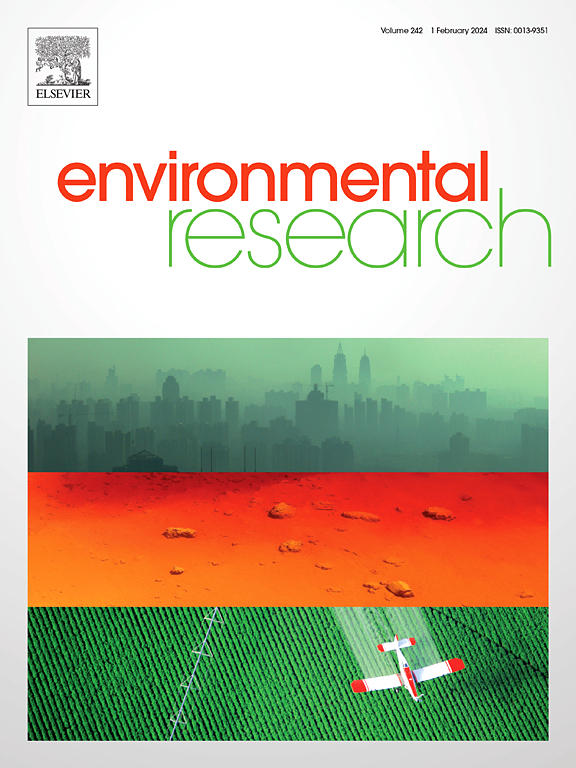形态工程多孔MgO高效CO2捕获和环丙沙星去除。
IF 7.7
2区 环境科学与生态学
Q1 ENVIRONMENTAL SCIENCES
引用次数: 0
摘要
氧化镁的吸附性能主要取决于其结构和形态。多孔结构使MgO具有较高的比表面积和孔隙率,从而增强了质量扩散和吸附。然而,传统的多孔氧化镁合成方法通常昂贵、有害或耗时,并且通常缺乏对多孔结构的精确调制。因此,开发一种简单而经济的方法来制造多孔氧化镁是至关重要的。本研究以吸附CO2和环丙沙星(CIP)的廉价无机试剂为原料,采用简单高效的微波辅助水热法合成了多孔花状(F-MgO)和六方片状MgO (NP MgO)。同时,通过各种表征方法对MgO结构进行精确调控和分析。与NP MgO相比,F-MgO具有更高的比表面积、更小的晶粒尺寸和更丰富的活性位点,从而表现出更高的CO2捕获能力和CIP去除效率。此外,F-MgO对CO2/N2的选择性优于NP -MgO,并具有较高的循环稳定性。F-MgO和NP -MgO对CO2捕集和CIP的吸附符合准一级和准二级动力学模型和Freundlich等温模型。通过原位和常规傅里叶变换红外光谱证实了CO2和CIP在MgO上的存在状态,表明CO2和CIP在两种MgO结构上的吸附均以化学吸附为主,物理吸附为辅。本研究为设计和制备经济高效的多孔MgO吸附剂提供了一种策略,为实际环境修复提供了重要的优势。本文章由计算机程序翻译,如有差异,请以英文原文为准。

Morphology-engineered porous MgO for efficient CO2 capture and ciprofloxacin removal
The adsorption properties of MgO are predominantly determined by its structure and morphology. A porous structure endows MgO with high specific surface area and porosity, thereby enhancing mass diffusion and adsorption. However, conventional synthesis methods for porous MgO are usually expensive, noxious, or time-consuming, and typically lack precise modulation over the porous structure. Consequently, developing a facile and cost-effective approach for fabricating porous MgO is of critical importance. In this study, porous flower-like (F-MgO) and hexagonal flake MgO (NP MgO) were synthesized via a simple and efficient microwave-assisted hydrothermal method using cheap inorganic reagents for adsorbing CO2 and ciprofloxacin (CIP). Meanwhile, MgO structures were precisely regulated and analyzed through various characterization methods. Compared with NP MgO, F-MgO exhibited a higher specific surface area, smaller crystallite size, and more abundant active sites, thus showing a higher CO2 capture capacity and CIP removal efficiency. Moreover, F-MgO showed a CO2/N2 selectivity exceeding NP MgO and featured a high cycling stability. The adsorption of CO2 capture and CIP by F-MgO and NP MgO followed pseudo-first and pseudo-second-order kinetic models and the Freundlich isotherm model. The existence states of CO2 and CIP on MgO were confirmed by in situ and conventional Fourier transform infrared spectroscopy, suggesting that the adsorption of CO2 and CIP on both MgO structures was mainly dominated by chemisorption, supplemented by physisorption. This study provides a strategy for designing and preparing cost-effective and efficient porous MgO adsorbents, offering significant advantages for practical environmental remediation.
求助全文
通过发布文献求助,成功后即可免费获取论文全文。
去求助
来源期刊

Environmental Research
环境科学-公共卫生、环境卫生与职业卫生
CiteScore
12.60
自引率
8.40%
发文量
2480
审稿时长
4.7 months
期刊介绍:
The Environmental Research journal presents a broad range of interdisciplinary research, focused on addressing worldwide environmental concerns and featuring innovative findings. Our publication strives to explore relevant anthropogenic issues across various environmental sectors, showcasing practical applications in real-life settings.
 求助内容:
求助内容: 应助结果提醒方式:
应助结果提醒方式:


